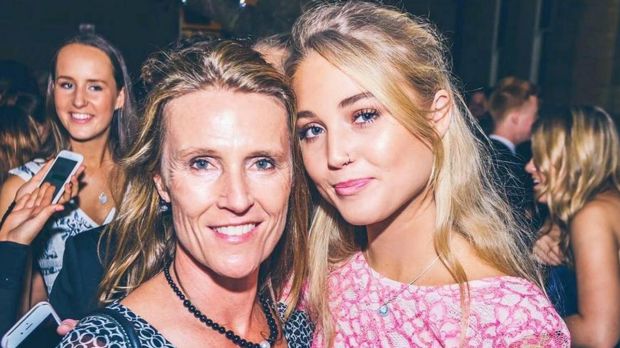Rebecca Gallagher was less than six months into her first semester when she was found dead inside her University of Sydney college dormitory.
She had been inactive for a day on Facebook messenger, her classmates say, which was unusual for the vivacious former Kincoppal-Rose Bay pupil who had a habit of collecting friends.

The last day of semester in June 2016 should have been a time of celebration for the students of St Andrew's college. .
But the girl affectionately known as Bec had not been seen since she was dropped off at the college's gate 24 hours earlier.

Concerned, her friends contacted the college's vice-principal Hester Wilson.
With no response emerging from inside the 18-year-old's dormitory, Dr Wilson used a master key to open her bedroom.
Inside she found Bec wearing her pyjamas, her hand cradling her head, dead.
Bec, the daughter of two doctors, Bondi GP Virginia Solomon and Riverina cardiologist David Gallagher, had died from complications believed to be associated with anorexia nervosa.

A NSW Police spokeswoman said a report was being prepared for the coroner.
In her death notice, the family asked that in Bec's memory donations could be made to the Butterfly Foundation, a charity that supports those suffering from eating disorders.

Now, more than a year after Bec's death, concerns remain about the impact of eating disorders in university college settings Australia wide, as thousands of high school students across the country prepare to decide if they will live on campus at a college next year.
University of Melbourne researcher Marie Camin said communal living, rigid meal times, and the college culture of sexual objectification could exacerbate eating disorders which affect up to one million Australians, according to a report from Deloitte Access Economics and The Butterfly Foundation.

Figures published by the National Eating Disorder Collaboration show one in 20 of those suffering from anorexia die, the highest mortality rate of any psychiatric disorder.
"If these girls have those risk factors to begin with and are exposed to a critical appearance focused culture it can serve as a trigger," she said.

Ms Camin points out that while body image is one issue, eating disorders are a complex mental illness associated with "control, perfectionism, high-achievement [and] low self-esteem".
Grace,*19, a second year college student at the Australian National University, said she developed an eating disorder by comparing how much she was eating to the other girls at her dining table.
"For me, I always missed breakfast and often lunch due to sleeping or class," she said.
"I then sort of realised how easy it was. When I went home [and] saw school friends everyone would comment on the weight I had lost."
Grace said she was aware of college men "rating girls at college events on their body" and that the "sexist culture" of some colleges made young women anxious about over-eating.
In 2016, five male college students were expelled from ANU and another two suspended for taking "creep-shot" photos down female students' blouses, and rating them on a secret male-only Facebook group.
Another woman, Evie,* said she was diagnosed with anorexia and bulimia while attending UNSW between 2013 and 2016.
"College can be an incredibly lonely place despite there being so many people," she said.
"I got away with eating watermelon for breakfast and lettuce and beans for lunch and dinner."
Former ANU student Kylie,* 23, said there was a contagious anxiety effect.
"One girl would go through other people's food to monitor what they were eating," she said.
"She would try to force other girls to eat chocolate bars [to make herself feel better], and became very competitive."
She said the pressure to exercise and the existence of communal bathrooms were other factors.
"You see people naked, or semi-naked quite a bit [and this invites social comparison]," she said.
Ms Camin said sufferers often experience distorted self-perceptions.
"A student may think 'she looks thinner than I do, and I should be eating less," she said.
"Even if a girl is thinner than someone, there is no end post. Whatever they are trying to obtain, you never obtain it.
"You die before you get there".
Other college students have told Fairfax Media of regularly smelling vomit in the bathrooms and a culture of girls binge-drinking and then vomiting to expel calories, before continuing to drink in a phenomenon colloquially known as "drunkorexia".
It is a behaviour encouraged by the initiation games at many Australian colleges. In a Facebook post published in 2015, a St Andrew's senior tutor encouraged students to undertake a "Bachelor of Inebriation" by consuming 15 drinks at eight different venues while vomiting on "chunder markers".
A 2013 study of 139 female Australian university students aged between 18 and 29 published in the Journal of Eating Disorders found up to 79 per cent had engaged in "drunkorexic" behaviour at one time or another.
Butterfly Foundation CEO Christine Morgan said it was important for college staff to be educated and have an awareness of symptoms associated with eating disorders.
"Colleges should have appropriate health professionals, services and information available to support or refer college residents," she said.
If you, or anyone you know is experiencing an eating disorder or body image concerns, you can call the Butterfly Foundation National Helpline on 1800 33 4673 (ED HOPE) or email support@thebutterflyfoundation.org.au
*Names have been changed at the request of those who have experienced an eating disorder.